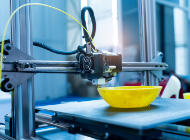
Material jetting is known to be one of the fastest and most accurate 3D printing technologies nowadays. This technology was patented by Objet Ltd. in 1999. It was under the name of PolyJet which then merged with Stratasys in 2012.
Material jetting is used in different sectors because of its many benefits. These include exceptional resolution up to 0.016mm., smooth surfaces and wide range of materials and colours. This technology is also known for producing 3D objects that combine several materials and colours.
To know more about this 3D printing technology, here is a blog post on about how material jetting 3D printing works. Read on here.
What is Material Jetting?
Material jetting is a relatively new 3D printing technology today. It uses liquid photopolymer and UV light to print 3D parts.
In this technology, photopolymer resin is sprayed in droplets before it is solidified. With the nature of this technology, it is often compared to 2D inkjet process. Nevertheless, inkjet printers only deposit a single layer of ink droplets while material jetting creates an object layer upon layer until it is finished.
Material jetting is also compared to SLA 3D printing. This is because both of them uses UV light to cure the resin. The only difference is that SLA 3D printer uses a vat of resin which is selectively cured by a laser while material jetting 3D printer creates object by spraying hundreds of tiny droplets at a time.
Common material used
This 3D printing technology commonly uses thermoset photopolymer resins. In terms of properties and limitations, this material is similar to those materials that are used in SLA. Thermoset photopolymer resins come in a less viscous and ink-like form.
The process
Here is a quick guide on the process of material jetting 3D printing. Read on below.
- The process begins with pouring the resin material into a container. This liquid resin is heated to 30-60ᵒC to achieve optimal viscosity.
- The print head begins to travel over the build platform. It will also selectively deposit hundreds of tiny droplets on the desired locations.
- Then a UV light source that is attached to the printhead cures the jetted or deposited material. The material will solidify. Then the first layer of the 3D part is created.
- After printing the first layer, the build platform moves downwards one layer height. The process repeats until the entire part is complete.
Characteristics of material jetting
Below are some of the distinct characteristics of Material jetting. Read on below.
-
Printer parameters
Most of the process parameters of material jetting 3D printers are pre-set by its machine manufacturer.
The layer height is also linked to each specific material. This is because of the complex physics of droplet formation. For material jetting, the typical layer height is 16-32 microns.
Material jetting has a dimensional accuracy of ±0.1%. It has a typical lower limit of ±0.1mm. With this, material jetting is considered to be one of the most accurate 3D printing technologies.
-
Line-wise deposition
One distinction of material jetting is how its material is deposited. This approach is called line-wise deposition. Basically, the printheads of material jetting printers are attached to the same carrier side by side. Thus, it deposits material on the whole print surface in a single pass.
In this manner, different print heads can dispense different materials. Hence, full-colour printing, multi-material printing and using dissolvable support structures are straightforward.
-
Multi-material and full-colour printing
Material jetting is popular for producing 3D parts with accurate multi-material and multi-colour. This characteristic can be employed at different levels.
- At the build area level – material jetting 3D printers can print different parts in different materials or colours simultaneously. In this way, manufacturing process can speed up.
- At the part level – 3D designers can designate different sections of a part to be printed in different material or colour.
- At the material level – with material jetting, two or more printing resins can be mixed in different ratios before it is dispensed. This will create “digital material” with specific physical properties such as stiffness, hardness or hue.
-
Surface finish
There are two surface finishes that are available in material jetting 3D printers. These are glossy and matte finish.
The glossy setting is used when a smooth shiny surface is desired. Printing with a glossy finish is cheap because it uses less material. However, expect not uniform finish and slight rounding of its sharp edges and corners.
On the other hand, matte finish is used when accuracy and uniform surface finish is required in a 3D part. Compared to glossy finish, the matte finish is a bit costly because more material is used. Moreover, additional post-processing time is needed.
Applications
Material jetting is usually applied for the production of detailed, realistic-looking and functional prototypes. This technology is particularly utilised by the medical sector. This is because of its ability to create anatomical models to scale, complete in different colours.
Apart from that, architects, artists, designers and even jewellery-makers can also benefit from this technology. Its precision and aesthetic quality make it more appealing to other industries.
Conclusion
Material jetting may not be as popular as the other 3D printing technologies. Nevertheless, it can benefit different industries that require aesthetic quality, high resolution, multi-material and multi-coloured parts. It is also considered as one of the fastest and most precise 3D printing technologies today.
For those who are interested in 3D printing, make sure to ask assistance from your trusted 3D printing service provider. They offer 3D printing services such as custom 3D printing, industrial 3D printing, 3D design and modelling and many more.







